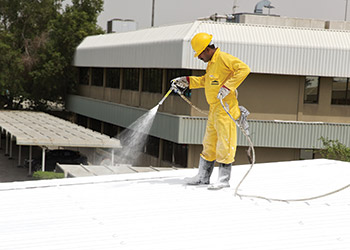 Cool roofs ... achieved through Dow’s Primal EC4642 ME acrylic emulsion.
Cool roofs ... achieved through Dow’s Primal EC4642 ME acrylic emulsion.
Dow has developed two new binders which, when used in coatings and paints, result in benefits to end-users in terms of costs and cleaner air.
Dow Construction Chemicals’ Primal EC4642 ME cuts power bills by keeping roofs cooler, while Dow Coating Materials’ Primal SF-208 ER helps improve indoor air quality.
The water-based Primal EC4642 ME acrylic emulsion is the latest development from Dow, which has many years of experience in developing products for elastomeric roof coatings, including cool reflective roof coatings (CRRCs) or “cool roofs”. The emulsion is a critical component in CRRC formulations and was developed specifically for the Middle East’s extreme heat and dust, says a spokesman for Dow.
With the tailored polymer binder, Dow enables manufacturers offer customers long-lasting energy-efficient CRRCs in the Middle East.
“CRRCs are designed to decrease the amount of heat which can penetrate into buildings, reducing ambient air temperatures and, therefore, the need for air-conditioning – which can in turn reduce the cost of cooling a building by as much as 20 per cent,” says the spokesman.
He adds roof surfaces are coated with materials with high solar reflectance to reflect solar radiation, as well as high infra-red emissivity to release absorbed heat.
The new product is designed to cope with surface temperatures in excess of 80 deg C. In addition, the binder offers long-term dirt pick-up resistance – essential for maintaining the solar reflectivity which is key to achieving energy savings – and high UV (ultraviolet) resistance, critical for an application constantly exposed to harsh Middle East sunlight.
 |
|
Cool roofs ... achieved through Dow’s Primal EC4642 ME acrylic emulsion. |
“Binders are most critical in terms of impact on functionality of roof coatings, as not only do they represent the majority of raw material used, they must deliver against tough performance criteria necessary for an application which comes under extreme mechanical and outdoor exposure stresses,” he says.
CRRCs are by no means limited to residential applications, as proven by a test case in Dubai’s Jebel Ali Free Zone, supported by the Trakhees-EHS regulatory authority which oversees sustainable development in the free zones of the UAE emirate.
“Dow teamed up with formulator and applicator Henkel Polybit to create a demonstration application incorporating CRRCs on a one-storey building owned by Trakhees-EHS in the Jebel Ali Free Zone,” says the spokesman.
He says this building is used for training purposes and referred to as “Green Gallery”. The one-storey building was due for renovation, and owner Trakhees-EHS was eager to try a new CRRC developed by Henkel in partnership with Dow, for use as a pilot study.
“This test case has shown significant advantages and other developers are now being asked to consider applying CRRCs to buildings in the future, as Dubai intensifies its focus on energy efficiency,” he adds. “Installing CRRCs brings advantages to developers and building owners as the solution helps to increase the value of properties not only thanks to higher energy efficiency. Durable CRRCs lead to an expanded lifetime for the roof, by protecting it from environmental degradation and help reduce the effect of peak temperatures and resulting mechanical stress, all of which increase longevity.”
Meanwhile, Dow Primal SF-208 ER is a low-odour, self-film forming acrylic binder which helps interior paint manufacturers in the Middle East to improving indoor air quality (IAQ).
Primal SF-208 ER has been created using the Dow’s Formashield technology, which was developed in response to concerns about IAQ and health effects associated with exposure to formaldehyde. Formashield is designed to remove formaldehyde from ambient air in buildings, through a process which triggers a chemical reaction between formaldehyde and the binder – transforming indoor air pollutants into harmless vapours.
“Formaldehyde is a colourless, flammable, strong smelling chemical used in building materials such as particleboard, plywood, fibre boards and many other household products. It can also be found in glues and adhesives, paper product coatings and some insulation materials,” says the spokesman.
 |
|
Formashield is designed to remove formaldehyde from ambient air. |
He says the substance has been listed by the European Union as of high concern due to its direct association with serious health issues such as respiratory diseases, allergies and even lung cancer. China was one of the first countries to proactively address the issue by setting a limit on ambient air formaldehyde levels in living spaces (0.08 mg per cu m), and several other countries including the US, Germany, Australia and Switzerland have followed suit.
He says: “With the UAE having one of the highest asthma rates in the world (13 per cent based on a 2013 Dubai Health Authority study), it is expected that interest in improving IAQ and reducing ambient formaldehyde levels in interior spaces will rise in the region and across the Middle East as a whole.”
Dow’s Formashield formaldehyde abatement technology is meant to be used as an active solution to address high indoor aldehyde levels. Paint manufacturers in a number of regions are already using it to create functional coatings that can help purify indoor air, says the spokesman.
With some countries introducing regulations to help driving indoor air quality improvements, there has been an increasing interest in Dow technology, simply because it goes beyond reducing emissions from paints and actively removes indoor pollutants emanating from other sources in homes and buildings.
The low-odour, self-film forming acrylic binder also offers excellent washability and adhesion, and comes in flat to satin sheens, offering interior paint producers the high performance and flexibility they demand, he adds.
Developments such as Formashield demonstrate Dow’s ongoing commitment to innovations that support sustainable solutions and enable a healthier building environment. “The Middle East will continue to make advances in ‘green’ building standards, and Dow’s technologies will be designed to support the region’s ambitions for better building and improved quality of life,” concludes the spokesman.





















_0001.jpg)


.jpg)
















.jpg)








.jpg)


